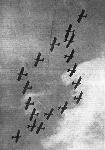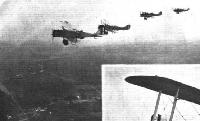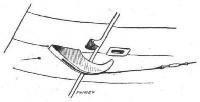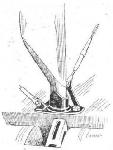
Fairey Pintail и Fawn
Спецификация Министерства авиации от мая 1919 года к двухместному гидросамолету-амфибии, способному эксплуатироваться с авианосцев, привела к появлению двух машин: Parnall Puffin и Fairey Pintail.
Последний стал первым самолетом, полностью спроектированным на "Fairey" после окончания Первой мировой войны. Первый из трех прототипов Pintail Mk I поднялся в воздух 7 июля 1920 года, 25 мая 1921 года полетел Pintail Mk II, а 8 ноября 1921 года - Pintail Mk III. Варианты отличались друг от друга длиной фюзеляжа и типом амфибийного шасси, которое доставило немало проблем конструкторам, прежде чем было принято решение делать колеса не убираемыми, а частично утопленными в поплавки.
Пока Великобритания не спешила заказывать самолеты, три машины в августе 1923 года заказали японские ВМС. Первый из них выполнил первый полет годом позже, все три самолета поставлены в ноябре 1924 года. В конструкцию самолетов для Японии внесли ряд изменений (в частности был увеличен зазор между крылом и фюзеляжем), эти машины известны как Pintail Mk IV. Всего построили шесть Pintail, но самолет обладал существенным потенциалом, что побудило фирму разработать сухопутный вариант Fairey Fawn, удовлетворявший спецификации 5/21 к биплану для взаимодействия с армейскими частями. Однако проект выполнялся по более поздней спецификации на дневной бомбардировщик. Прототип Fawn выполнил первый полет в марте 1923 года, но испытания выявили необходимость удлинения фюзеляжа.
Следующие две машины построили в удлиненном варианте Fawn Mk II. За ними последовали еще две опытные машины, а первый серийный самолет полетел в январе 1924 года.
Было заказано 50 серийных Mk II, затем еще две серии общим количеством 20 самолетов Fawn Mk III с моторами Napier Lion V вместо Lion II. Несколько Fawn поздней постройки получили моторы Lion VI с турбонагнетателями, на вооружение строевых частей они не передавались и использовались только для летных испытаний.
ТАКТИКО-ТЕХНИЧЕСКИЕ ХАРАКТЕРИСТИКИ
Fairey Fawn Mk II
Тип: двухместный дневной бомбардировщик
Силовая установка: один W-образный ПД Napier Lion II мощностью 470 л. с. (350 кВт)
Летные характеристики: максимальная скорость на уровне моря 183 км/ч; крейсерская скорость на высоте 3050 м - 150 км/ч; время набора высоты 3050 м - за 17 минут 24 секунды; практический потолок 4220 м; дальность 1046 км
Масса: пустого 1579 кг; максимальная взлетная 2646 кг
Размеры: размах крыльев 15,21 м; длина 9,78 м; высота 3,63 м; площадь крыльев 51,10 м2
Вооружение: один фиксированный стреляющий вперед 7,7-мм пулемет Vickers по левому борту и два 7,7-мм пулемета Lewis на турели в задней кабине; до 209 кг бомб на внешней подвеске под нижним крылом
Описание:
- Fairey Pintail и Fawn
- Flight, July 1920
The Olympia Aero Show 1920
Фотографии
-
Мировая Авиация 97
Регистрационный номер: J6908 [2] Март 1924г.: Fairey Fawn, выпущенный в ограниченном количестве для британских ВВС, был одним из новых типов самолетов, появившихся после окончания Первой мировой войны.
-
Мировая Авиация 125
Регистрационный номер: J7187 Fawn состояли на вооружении пяти бомбардировочных частей, дислоцированных в Великобритании - 11-й, 12-й, 100-й, 503-й и 602-й эскадрилий. На фотографии - Fawn Mk II.
-
Aeroplane Monthly 1993-02 / O.Thetford - By day and by night /The classic inter-war RAF biplane bombers/ (9)
Регистрационный номер: J7206 [2] Fawn J7206 served with Nos 100 and 503 Sqns. The type was intended to replace the D.H.9A, an example of which is visible in the background.
Другие самолёты на фотографии: De Havilland D.H.9A - Великобритания - 1918
-
Aeroplane Monthly 1993-02 / O.Thetford - By day and by night /The classic inter-war RAF biplane bombers/ (9)
Регистрационный номер: J7206 [2] Fawn J7206 served with Nos 100 and 503 Sqns. The type was intended to replace the D.H.9A.
-
Aeroplane Monthly 1993-02 / O.Thetford - By day and by night /The classic inter-war RAF biplane bombers/ (9)
Регистрационный номер: J7190 [2], J7771 Production Fawns J7190 and J7771 (Mks II and III respectively) in service with 100 Sqn. J1790, which has an unconventional long exhaust pipe, had previously been used for short-wave telephony tests by the RAE.
-
Aeroplane Monthly 1993-02 / O.Thetford - By day and by night /The classic inter-war RAF biplane bombers/ (9)
Регистрационный номер: J7212 Fawn J7212 of 12 Sqn pictured in about 1925. On May 22, 1925, while serving with 100 Sqn, this aircraft caught fire in the air. It survived, and during 1928-29 it served with 602 Sqn.
-
Flight 1923-11 / Flight
At Croydon "review": The Fairey "Fawn," with Napier "Lion" engine, is a two-seater day-bomber. The petrol tanks are mounted above the top plane.
-
Flight 1923-06 / Flight
THE FAIREY "FAWN," 450 H.P. NAPIER "LION": A "land" type long-distance reconnaissance machine.
-
Aeroplane Monthly 1993-02 / O.Thetford - By day and by night /The classic inter-war RAF biplane bombers/ (9)
Регистрационный номер: J7219, J7220 Fawn Ils J7219 and J7220, both of which served with 11 Sqn in 1925. J7220 ran into Westland Limousine G-EAFO at Netheravon on August 17, 1925, and was written off.
-
Flight 1927-03 / Flight
Регистрационный номер: J7198 Fairey "Fawn" (Napier "Lion"). In the Fairey "Fawn" we have what may be styled the modernised version of the famous "IIID" seaplane - still in use for Fleet Reconnaissance work - but designed as a two-seater long-distance day bomber. Strictly speaking, however, this similarity is confined to general appearance, for it differs from the IIID in several respects. Its distinctive features include the well-known Fairey patented flap gear and a special Oleo undercarriage. At present only two of our bombing squadrons are equipped with "Fawns," as follows :- No. 11 Netheravon, and No. 503 (Special Reserve) Waddington.
-
Jane's All the World Aircraft 1980 / Encyclopedia of Aviation - Aircraft A-Z - v3
Регистрационный номер: J6908 [2] First prototype Fairey Fawn II.
-
Aeroplane Monthly 1977-07 / Personal album
Регистрационный номер: J7190 [2] Flt Lt D. F. McIntyre, later to be a co-founder of Scottish Aviation Ltd at Prestwick, flying Fawn II J7190 of 602 (City of Glasgow) Sqn, Royal Auxiliary Air Force, over the Tay Bridge. This aircraft joined the unit in 1928.
Fairey Fawn Mk II two-seater day bomber J7190 “2” of No 602 (City of Glasgow) Sqn, Royal Auxiliary Air Force, photographed while flying over the Tay Bridge. The pennants on outer interplane struts and rudder indicate that this was probably the CO’s aircraft. The first Auxiliary Air Force squadron, Renfrew-based 602 received Fawns in place of its D.H.9As in 1927 and flew them until 1929. A 470 h.p. Napier Lion II was the powerplant. -
Flight 1929-01 / Flight Advertisements
Регистрационный номер: J7184 Actual photograph taken from accompanying 'plane, at instant after man had jumped and pulled the rip cord - his Irvin is seen instantly opening.
-
Aeroplane Monthly 1993-02 / O.Thetford - By day and by night /The classic inter-war RAF biplane bombers/ (9)
Регистрационный номер: J7209 Fairey Fawns of 100 (Bomber) Squadron flying for the RAF’s 1925 Hendon Air Display. In the foreground is Fawn II J7209, which first flew on March 19, 1924 and was finally written off when it crashed at Weston Zoyland in July 1925.
-
Flight 1925-07 / Flight
Wing Evolutions by four Bombing Squadrons (18 Fairey "Fawns," and 18 D.H.9a's). On the left the machines changing from "Wing Line Ahead Squadrons Line Abreast" to " Wing in Line Ahead of Squadrons." On the right two Squadrons changing from "Squadron" to "Squadron Mass."
-
Flight 1926-07 / Flight
MORE GROUP EVOLUTIONS: These were carried out by two Wings of two day-bombing squadrons (Nos .11 and 12, Fairey Fawns, and Nos. 39 and 207, D.H. 9As). In the top view the four squadrons flying together, and below, flying towards one another.
Другие самолёты на фотографии: De Havilland D.H.9A - Великобритания - 1918
-
Flight 1926-07 / Flight
A FINE FORMATION: Were each of the two day-bombing squadrons, in "Squadron" formation, pass over each other and produce a wonderful pattern.
Другие самолёты на фотографии: De Havilland D.H.9A - Великобритания - 1918
-
Flight 1926-07 / Flight
"A DRESS REHEARSAL": Some D.H.9a's of No.39 Bombing Squadron carrying out evolutions over Hendon. Note the formation of Fairey "Fawns" in the left-hand corner of the top picture.
Другие самолёты на фотографии: De Havilland D.H.9A - Великобритания - 1918
-
Flight 1926-07 / Flight
THE "SET PIECE" AT THE R.A.F. DISPLAY: An attack by fighters and day bomber on a hostile aerodrome. The views show No. 12 day-bombing squadron (Fawns), seen on the left, which blows up the hangars, as shown on the right.
-
Flight 1927-07 / Flight
THE MARCHIONESS OF TOWNSHEND'S AERIAL FETE: The young Marquis of Townshend seen here, a little too short for the Fairey "Fawn," cockpit.
-
Flight 1920-07 / Flight
THE FAIREY SEAPLANE AT OLYMPIA: This machine is a military type, designed for fighting. It carries a very complete armament of guns, and the tail is remarkable for the fact that there is no vertical fin above the tail plane
-
Flight 1921-11 / Flight
Регистрационный номер: N134 A FAIREY AMPHIBIAN: The photograph of the machine just after alighting shows the trailing edge of the wings pulled down to give greater lift. This hinged trailing edge is a feature of all Fairey seaplanes.
-
Flight 1921-11 / Flight
Регистрационный номер: N135 [2] TWO VIEWS OF THE FAIREY "PINTAIL": This machine is an amphibian with Napier "Lion" engine.
-
Flight 1922-12 / Flight
Регистрационный номер: N135 [2] The Fairey Amphibian "Pintail," Mark III, 450 h.p. Napier "Lion" Engine.
-
Flight 1924-12 / Flight
A MODERN FAIREY SEAPLANE: A side view of the Fairey "Pintail" Mark IV two-seater fighter seaplane, fitted with a Napier "Lion" engine.
-
Flight 1920-07 / Flight
One of the crank levers by which the camber is altered on the Fairey seaplane
-
Flight 1920-07 / Flight
The Fairey Seaplane XXI: Sketch showing the strut attachment and aileron hinge
-
Flight 1920-07 / Flight
A "FAIREY TAIL" AT OLYMPIA: There is no fin above the horizontal tail plane
-
Aeroplane Monthly 1993-02 / O.Thetford - By day and by night /The classic inter-war RAF biplane bombers/ (9)
Fairey Fawn squadron colors
-
Мировая Авиация 125
Fairey Pintail Mk III
- Фотографии
































